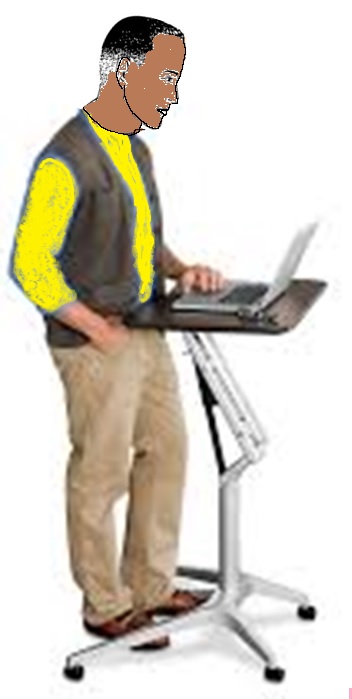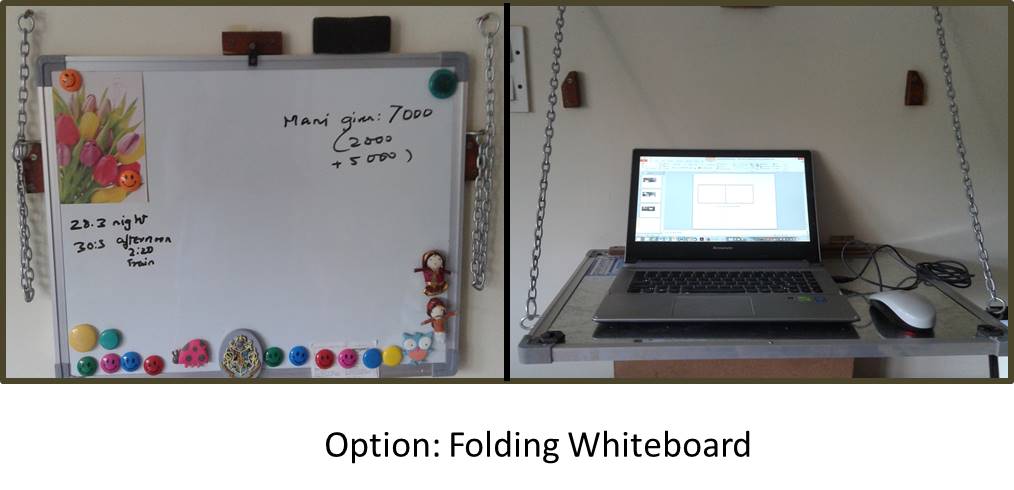Many of us who work in offices sit for more than 8-10 hours a day. We sit for our breakfast, we sit during our commute, we sit for long stretches at our desks, we sit with our coffee/ tea during the breaks, we sit for our lunch, we sit in meetings, we sit on our way back home, we sit during dinner and watch TV while sitting. And many times we sit continuously for more than 2 hours without getting up.

Being able to sit is also a status symbol that displays higher education and higher income / wealth. People who are more educated typically have jobs that require them to be on desks; richer people do not walk to bus stops and train stations, nor do they walk to shopping centers or coffee shops.
Over the last few years there has been a concerted movement in some countries (like Australia) to encourage people to sit for lesser time during the day, reduce continuous sitting, and increase time standing and moving. However, this movement has not yet picked up any steam in India.
Summary of the Findings
Prolonged sitting has been linked with multiple health concerns like obesity, increased blood pressure, high blood-sugar, excess body fat around the waist and abnormal cholesterol levels. It also seems to increase the risk of death from cardiovascular disease and cancer. Sitting more than 6 hours a day may be as bad as smoking a pack of cigarettes every day.
Spending focused time at the gym or doing other vigorous activity doesn’t seem to significantly offset this risk.
The answer to improve the situation (according to current understanding) is as follows:
- As far as possible, avoid sitting
- Even if you have to sit, do not sit continuously for more than 20-30 minutes
- Get as much movement as possible (even standing up and stretching every 20 minutes is movement) whether you sit or stand at work
What One Can Do
- Stand while working or alternate between standing and sitting. There are small stools/ shelves/ stands that you can use to raise the height of your PC screen or laptop (options shown below).
- Avoid sitting where the task/ activity does not require you to sit. For example:
- Lunch and coffee breaks
- Meetings and training sessions
- Watching TV
- In waiting areas like airports, bus stands, railway stations
- If your job requires you to sit, get up frequently (like every 20 mins)
- Set alarms on your devices like laptops, smartphone, PC
- Keep things you need to access regularly slightly away – don’t keep them within reach while sitting (things like your smartphone, water-bottle, stapler, files, notebook, charger, etc.)
- Get as much movement as possible, whether you stand or sit at work
- Do not ask others to get stuff to your desk – fetch the things yourself
- If you need to talk to people in your office, walk up to them, instead of using the phone or chat or email or calling them over
- Hold ‘stand up’ meetings – they finish faster too. If possible hold them in an open area like a park or a garden
- When on phone calls (that do not require you to be on your desk to access information), walk around in the office
- Use the stairs, instead of the elevators and escalators
- While travelling on the road, if possible, get off your transport one or two kilometers before the destination and walk
Furniture Options to Create Standing Desks
Though there is specialized standing furniture available, the options for well designed standing work-desks or dual mode work-desks are limited in India. However, let that not be an excuse for you to postpone making changes. Given below are some options, cheapest ones being the first.

Business Opportunities
This presents a lot of opportunities in India for services and products, like:
- Designing office spaces to optimally encourage standing and movement, while also enabling sitting
- Designing cafeterias, restaurants, public transport, etc., with options for standing and movement
- Providing specialized furniture (like a rotating table for a team?) and gizmos (like a micro treadmill embedded in the floor?)
- Consulting and advice to corporates and employees to custom design their sit-stand-move mix
In future, maybe we will see:
- Passenger aircraft with a mix of standing, sitting, movement, and lying down options 🙂
- Cars and other vehicles where the driver and passengers can stand 🙂 🙂
- Devices that can help us stand and/ or exercise while sleeping 🙂 🙂 🙂
In case you need more detailed information on this topic, you may chase the key-words “sitting or standing at work” on the Internet search engines. You will be presented with a lot of pages, including detailed research papers.
By the way, most of this post was written while standing with movement to get water, open the door, a visit to the bathroom and one to make coffee!
Please feel free to share your views, experiences, and queries, using the “comments” feature.





Nice Article with some innovative ideas towards the end. While sitting for too long is definitely not good, neither standing is. It will lead to complications like Varicose veins. Moving or Walking is preferable to standing. But again we need to strike a balance between sitting, standing and walking. For an average sized person what do you think should be the ratio of these three activities ?
Thanks, Gopi.
Here are some recommendations in an article available at http://ergo.human.cornell.edu/CUESitStand.html:
“Sit to do computer work. Sit using a height-adjustable, downward titling keyboard tray for the best work posture, then every 20 minutes stand for 8 minutes AND MOVE for 2 minutes. The absolute time isn’t critical but about every 20-30 minutes take a posture break and stand and move for a couple of minutes. Simply standing is insufficient. Movement is important to get blood circulation through the muscles. And movement is FREE! Research shows that you don’t need to do vigorous exercise (e.g. jumping jacks) to get the benefits, just walking around is sufficient. “
Thanks Rajesh. I will go through the article.
I am used to sitting for long hours in front of the laptop. And in front of the screen while watching cricket.
And while I am preparing for the marathon “sitting”, in order to prevent the need for “movement”, I make sure that all comforts- water, chips/munchies, mobile are nearby !!!
I also discover that sitting at a place for long hours induces an inertia which makes “movements” really undesirable. A bio-break also seems quite a disruption!!
I somehow had the feeling that doing a 45 min stretch and yoga in the morning offsets the side effects of “non-movement” for the rest of the day.
Regards
Prakash
Hi Prakash,
Having all things accessible when you sit seems to be aligned to the principles of “5-S”. However, they are not optimal for healthy living.
By the way, not taking bio-breaks may be dangerous in more ways than one. Using the 5-S principles, you should have whatever is required for the bio-break placed beside you (maybe in the next marathon TV session 🙂 ).
Cheers,
Rajesh
Ha..haaa.
In fact the other article you had posted earlier that provided tips on how to reduce eating impulses challenged my 5-S ecosystem around me.
I was brought up thinking that “ability to concentrate” was a virtue and “sitting for long hours reading” without breaks was a good indicator of studiousness. Enhanced your academic disposition. In fact I know my mother used to feel happy to see me so focused (“on studies” or on the comic hidden within the geography book was a matter of speculation). That put me into this habit of “sitting” (no movement) and “concentrating” on whatever for long periods of time.
And now all health tips seem to indicate that “taking breaks” and “moving around” is the right thing to do, which means changing my intrinsic habit.
I also feel that any break kind of disrupts the thinking process and sometimes threatens to discontinue the activity started. Because physical movement can change the mood and going back to the “sitting posture” to continue what was started seems “arduous”. How does one reconcile these states of motion?
Regards
Prakash
You can start taking the breaks while watching TV programs and sports matches – commercial breaks are anyway part of the deal.